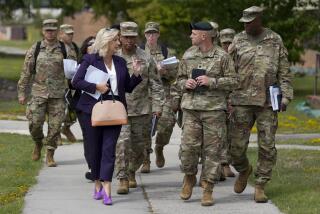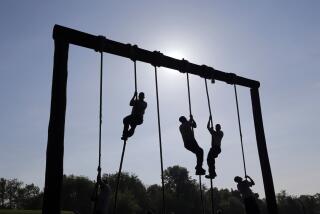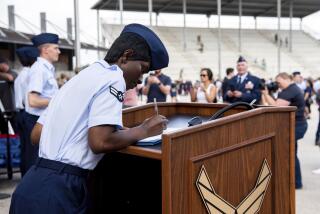Not All of the Pitching and Tossing Done Aboard Ship : Softballer Just One of Many Top Service Athletes
The hard steel deck of a seagoing frigate isn’t the best place for one of the best softball players in the Navy to sharpen his skills.
At sea, there are no swept-clay infields. There aren’t any emerald outfields to smash softballs across. At sea, there are only cramped sleeping quarters and cold metal bulkheads--and miles and miles of ocean.
Data systems Tech. 3rd Class Steve Hollimon, a computer technician, spent two of his 24 years feeling the deck of the guided missile frigate Vandegrift pitch and toss under his feet. But it wasn’t the kind of pitching or tossing he would have liked.
Hollimon’s passion is softball, and he’s very good at it. So good that he was selected in 1986 and 1987 to the All-Navy softball team, all-stars who take on outstanding players from the Air Force, Army and Marines in the annual Interservice Softball Tournament. That’s Class-A slow-pitch softball--a level that would make most of the guys on the diamond of your local park look like Little Leaguers.
In 1987, when Hollimon shipped out with the Vandegrift for a globe-circling cruise, he did what he could to stay fit for softball: pumped iron in the Vandegrift’s weight room. The frigate made port visits in far-off places like Mombasa, Kenya, and Karachi, Pakistan. Then there was a harrowing convoy escort through the Persian Gulf during which the Stark, a ship of the same class, was hit by an Iraqi missile.
Through it all, Hollimon bulked up his biceps.
“There’s certain things that you just can’t do at sea,” Hollimon said. “You might as well forget about free weights when you’re taking the big 10-degree rolls. But you can work out on Universal machines.”
Today, on solid land, Hollimon is assigned to the supply department at the Long Beach Naval Station and plays for its varsity softball team.
Hollimon is awaiting his discharge so didn’t go to the interservice tournament this month. But he’s just one example of the splendid athletes sprinkled throughout the military.
During wartime, that talent has never been hard to find.
In World War II there were many: Brooklyn shortstop Pee Wee Reese, slugger Ted Williams, Joe DiMaggio, an endless parade of stars.
In peacetime, the list is long, too. Roger Staubach was a naval officer. Napoleon McCallum and David Robinson are naval lieutenants with their best athletic feats still ahead of them. Alonzo Babers, who won the gold medal in the 400-meter dash at the 1984 Olympic Games, was a lieutenant in the Air Force. When Billy Mills won Olympic gold in the 10,000 meters in 1964 in Tokyo, he was a Marine lieutenant.
Tech. Sgt. Virgil Ferguson, 36, who has worn the Air Force’s cloth for 16 years, has a unique claim to fame: He’s probably the only sergeant in the Air Force who has coached in a basketball game against Paul Landreaux.
Ferguson handles classified documents in the Special Security Office at the Air Force Station in El Segundo. Last winter, though, Ferguson found himself on the sideline opposite Landreaux, the coach who took his El Camino team to the California community college title.
Ferguson, a career serviceman, skippers the varsity basketball and softball teams at the base. When he was scheduling games for his basketball team last fall, he added the names of Marymount Palos Verdes College, Pasadena, Compton and East Los Angeles colleges--and El Camino.
“Playing against El Camino was almost like playing a major college team,” Ferguson said.
The Air Force hoopsters played tough but lost, 93-72. The high scorer for the Air Force was their swingman, Airman Oscar Naylor. Naylor averaged 31 points per game, and Ferguson often saw assistant coaches from George Raveling’s USC program scouting him.
Ferguson’s team struggled to a 9-18 record against a tough schedule. Landreaux is now an assistant to Jim Harrick at UCLA, and he probably wouldn’t like to see Naylor trade his Air Force blue for the crimson and gold of the Trojans.
And even though he’s a hoop-loving Hoosier from the farmlands around Owensville in southern Indiana, Ferguson is now coaching the El Segundo station’s varsity softball team--which is 18-11 in weekend tournaments against other Air Force bases.
In today’s broad military athletic programs, a grain of talent can lead a serviceman all the way up the ladder from intramurals to a station-level varsity team to the Olympic Games.
“Our main concern in athletics is participation,” said Houston Rogers, the civilian athletic director for the 5,000-man Space Division at the El Segundo station. “But if we find talented athletes in our ranks, we’ll send them to the base that’s hosting their particular sport.” The Air Force, like other services, uses sports camps to select the top athletes in the branch.
Two outfielders from Ferguson’s varsity softball team--Staff Sgt. Doug Fletcher and 2nd Lt. Vic Folk--were named to the Systems Command team and competed in the Air Force tournament in July at Goodfellow AFB in Texas. The top players in the tournament were picked to play in the Interservice Softball Tournament at San Diego Naval Station.
“If you’re talented enough, you can play ball four or five months out of the year in the Air Force,” Ferguson said. “But you have to have a good boss who can release you from your job.”
Ferguson will be stationed at El Segundo for his final four years in the Air Force. He’ll continue to coach, but he admits his playing days might be numbered.
“If I ever have to sub into a basketball game, they have to have the oxygen tent waiting for me after six or seven trips up the floor,” Ferguson said. “I like to leave the playing to the younger guys.”
Chief Signalman Barry Yarbrough has a mission in teamwork. From the deck of the naval tugboat Tuscumbia, Yarbrough watches the tiny tug prod giant warships of the Pacific Fleet into berths. But when he’s not working, Yarbrough coaches the Long Beach Naval Station’s varsity softball team--an elite band of 16 players picked from the station’s complement of 15,000 personnel.
“Teamwork is one thing we don’t have to practice when we get onto the softball field,” Yarbrough said. “Teamwork comes with the territory.”
So do athletics, apparently. Athletic Director Marty Winfield, who oversees the $10 million recreation program at Long Beach Naval Station, estimates that 60% of the station’s personnel participate in a sports--”whether it’s running, fitness or general open play.”
Winfield organizes the station’s intramural programs, which run the gamut from flag football to tennis and softball. Every year, sailors from the 35 ships permanently ported at Long Beach grapple for the Captain’s Trophy by racking up intramural points. Last year, shipmates from the Racine, an LST, won the award by sweeping the basketball competition.
Yarbrough coaches the only station-level varsity team at Long Beach Naval Station this year. Last year Chief Petty Officer Ron Maher coached a basketball team of hot-shooting sailors from the battleship Missouri and ended up playing the community college tour.
But Capt. Walter R. Heinicke, commanding officer at the Long Beach station, said the Navy has been a bit slower than the other services in developing a recreation and fitness program because of inherent problems of naval work.
“Athletics get to be a bit uncomfortable at sea, especially when you’re confined to a small ship,” Heinicke said. “Navy personnel can’t do much with athletics at sea unless they’re assigned to an aircraft carrier where they can literally run the length of the flight deck.”
Heinicke and Winfield are proud of their port’s extensive athletic facilities, which handle 9,000 sailors on an average day when elements of the fleet are out to sea in the Western Pacific or the Persian Gulf.
Long Beach’s fitness center, backed by non-appropriated funds, has been rated the best in the Navy. Two years ago, the center underwent what Heinicke called “a sailor-powered transformation”--the station’s men did the lighting, painting and carpeting of the weight and locker rooms at a substantial savings to the government. Today, it has the veneer of a slick suburban health club, with mirrored walls, Lifecycles and Nautilus equipment.
Yarbrough’s varsity softball team is playing tournaments “in town” and against other naval bases from Point Mugu to China Lake. It’s a good team. Two of its sailors have played for the All-Navy squad in the Interservice Softball Tournament. Hollimon was on the All-Navy team in 1986 and 1987, and Machinist’s Mate 3rd Class Eddie White--a barrel-chested Kirby Puckett look-alike--saw All-Navy action in 1984.
Softball players at that level are usually former baseball standouts. White played baseball at St. Augustine’s College in Raleigh, N.C., and then a year of professional ball for the Cincinnati Reds’ Rookie League affiliate at Sarasota, Fla., before joining the Navy.
Yarbrough started his varsity team by posting a tryout announcement. Forty sailors responded, but by August the team had been whittled to a hard 16. The remaining members spend most of their spare time practicing and playing against local teams and fire and police department clubs.
“We eat softballs for breakfast,” said Electrician’s Mate 2nd Class Joe Pueliu, a criminal investigator at the Long Beach station and the shortstop for Yarbrough’s team. “Then we eat ‘em for lunch and dinner, too.”
Ferguson remembers the first lesson the Air Force taught him 16 years ago:
“If you don’t play team ball you don’t play at all. From Day One, your personal identity is taken away and you’re molded into a military person. The military tries to weed out the prima donnas and teach them to work as a team.”
And teamwork means that military obligations always come first. A good day for Yarbrough is when he schedules a practice and “13 out of 16 don’t have immediate military obligations.
“We schedule games and practices, but we’re always aware that it’s all subject to last-minute changes at any time.”
White, a power-hitting outfielder, agreed. He was transferred to the station’s supply department after leaving his last assignment, the amphibious cargo ship Mobile, in February.
“In the Navy, when you get a set of orders, you’re not going to go play ball,” White said. “When you get your orders, you’re going to go to a ship.”
One of the perks of playing base-level varsity sports, Ferguson said, is representing the service in public.
“You get to be the go-between between the civilians and the Air Force,” Ferguson said. “We love playing sports and all, but we also know what our job is.”
For Ferguson, that means constantly reminding his players to remember military decorum on the field.
“I never let my players do any arguing,” Ferguson said. “I tell them to let me act like the crazy man. I’m the leader as far as getting thrown out of games and drawing technicals.”
Yarbrough, a 12-year veteran of the Navy, takes a similar approach to coaching.
“You really have to direct traffic in this position,” Yarbrough said. “When players are this good and talented you can imagine all the energy they want to expend. But we do represent the Navy so we can’t go out there acting wild and crazy. We’ve got some hotheads on this team, but they pretty much keep it to themselves.”
That takes discipline, but military personnel are indoctrinated from the beginning to respect leadership. On varsity and intramural teams, it’s not uncommon to find officers and enlisted men playing on the same team.
Heinicke, who formerly coached rugby at the Naval Academy, said that military tradition and protocol stay generally intact on the playing field.
“You hear things like, ‘Nice shot, sir’ all the time,” Heinicke said.
Ferguson has only one officer, Maj. Al Chubbs, an outfielder, on his softball team.
“Sometimes I have to remind some of the younger officers that once we get on the team van, the coach is in charge,” Ferguson said. “Just because a guy’s a lieutenant colonel, he can’t say, ‘I’m a lieutenant colonel, you’re a tech sergeant, so put me in the starting lineup.’
“But when we get back to the base, the colonel is ‘Sir’ and the sergeant is still a sergeant.”


